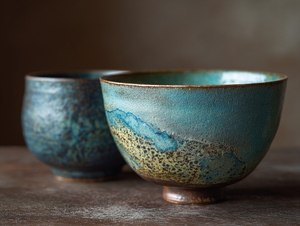Agano ware

Agano ware (上野焼, Agano-yaki) is a traditional Japanese pottery originating from Fukuchi Town in Tagawa District, Fukuoka Prefecture. Renowned for its elegance, lightweight construction, and distinctive glazes, it holds a significant place in Japan's ceramic heritage.
History
[edit]Agano ware traces its origins to 1602 when Sonkai, a potter from the Kingdom of Joseon (modern-day Korea), was invited by the daimyo of Kokura Domain to establish a kiln in Agano. This initiative was supported by Hosokawa Tadaoki, a prominent tea master of the era.
The kiln became renowned for producing tea ceremony utensils, aligning with the aesthetic principles of wabi-sabi—emphasizing simplicity and understated beauty. By the mid-Edo period, Agano ware was recognized as one of the "Seven Kilns of Enshū", a group of esteemed kilns favored by tea master Kobori Enshū.
Characteristics
[edit]- Material: Agano ware is typically crafted from local clay found in the Fukuchi region, contributing to its unique texture and appearance.
- Design: The pottery is characterized by thin, lightweight construction, offering a refined tactile experience. Its designs often feature subtle curves and minimalist forms, reflecting Japanese aesthetics.
- Glaze: A hallmark of Agano ware is its diverse glazing techniques. The most notable is the copper-based green rust glaze, which produces a vibrant blue-green hue. Other glazes include iron, white-brown, and transparent finishes, each imparting a distinct character to the pieces.
Cultural significance
[edit]Initially produced for tea ceremonies, Agano ware embodies the spirit of wabi-sabi—appreciating the beauty in imperfection and transience. Its association with tea culture has cemented its status as a symbol of refined Japanese craftsmanship. Today, Agano ware continues to be cherished by tea masters, collectors, and enthusiasts worldwide.
